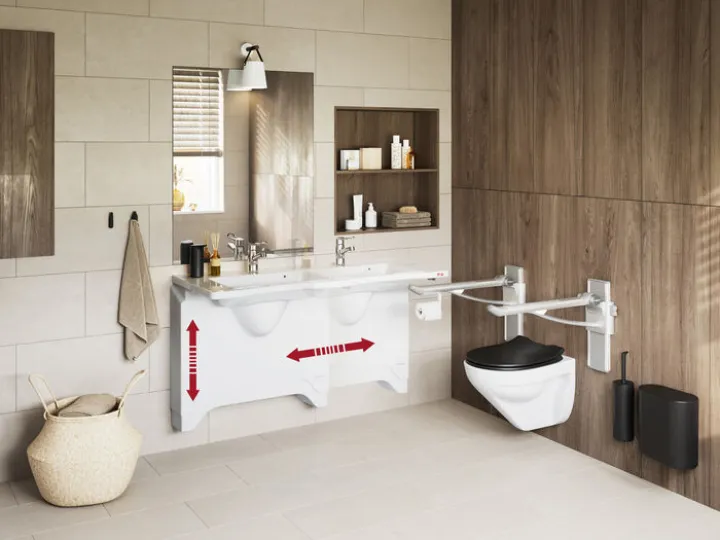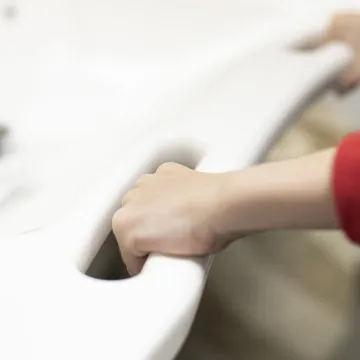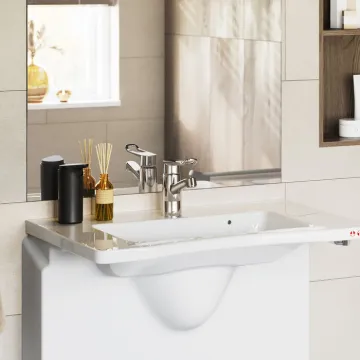Space Race
Creating space in accessible bathrooms: Pressalit explain the role of adjustable washbasins in enhancing mobility and independence.
In the realm of inclusive design, creating accessible bathroom spaces that cater to individuals with reduced mobility is a challenge that requires thoughtful consideration and innovative solutions.
For anyone who plays a critical role in ensuring that environments are safe and supportive for all users, the bathroom often presents one of the most complex spaces to design effectively. With limited square footage, the need for careful planning is paramount to accommodate the needs of those who use wheelchairs, mobility aids, or require assistance from caregivers.
One innovative solution that has emerged to address these challenges is the use of adjustable bathroom fixtures, particularly a height and sideways adjustable washbasin. This solution offers the flexibility needed to create a more functional and accessible bathroom environment.
Understanding the spatial needs in accessible bathrooms
To create a bathroom that truly meets the needs of all users, it's essential to start with an understanding of the spatial requirements involved. A standard ambulant adult typically requires around 600x600mm of floor space, and for wheelchair users, the dimensions increase significantly. Manual wheelchair users need at least 1200x750mm, while powered wheelchair users may require up to 1300x700mm.
These figures are just the baseline; additional space is needed for manoeuvring and for performing essential tasks such as side transfers onto the toilet.
The British Standard BS8300:2018, which provides guidance on the design of accessible and inclusive environments, recommends a minimum turning circle of 1500x1500mm for wheelchair users, with 2100x2100mm being ideal for those using larger powered wheelchairs. These dimensions must be kept in mind when planning bathroom layouts to ensure that users have sufficient space to move freely without obstruction.
In addition to space for the wheelchair itself, there must be adequate room for the user to access the toilet and washbasin comfortably. For example, a side transfer from a wheelchair to the toilet typically requires a clearance of about 950mm on one or both sides of the toilet. This can be a significant design challenge, particularly in smaller bathrooms where space is at a premium.
The role of an adjustable washbasin in space optimisation
In response to these spatial challenges, the concept of adjustable bathroom fixtures has gained traction. The Pressalit Matrix and Plus range of height and sideways adjustable washbasins is an exemplary solution that offers the flexibility needed to create a more adaptable and inclusive bathroom environment.
The Matrix small washbasin for the Plus system is designed with a 600mm width and a 600mm projection, dimensions that have been found to be optimal for seated users. The Matrix medium gives 780mm width for more support and 550mm projection for seated users. What sets these washbasins apart are the ability to move both vertically and horizontally, allowing them be positioned exactly where it is needed, depending on the user's requirements at any given time.
For instance, when space is needed near the toilet for a side transfer, the washbasin can be pushed towards the shower area, creating the necessary clearance. Alternatively, the washbasin can be moved closer to the toilet, enabling users to wash their hands while still seated before transferring back to their wheelchair.
This level of flexibility ensures that the bathroom space can be used efficiently without compromising on the usability of the fixtures.
Furthermore, the adjustable washbasin serves as a support tool for independent users in wheelchairs or people with a need for support when standing. The basin's ability to be positioned at the optimal height and proximity allows users to lean on it for stability, or to pull themselves closer to the basin, facilitating easier access. This additional support can significantly enhance user confidence and independence, allowing for safer and more comfortable self-care routines.
Enhancing support and user independence
In settings such as care homes and school hygiene rooms, where individuals may require assistance with daily tasks, the spatial dynamics become even more complex. Carers need sufficient space to move around and assist the person they are supporting. A typical carer might require at least 700mm of space to perform tasks such as bending over to help a seated user.
The adjustable nature of the Matrix washbasin is particularly beneficial in these scenarios. By moving the washbasin sideways, carers can create more room for themselves to operate comfortably, without encroaching on the user's space.
This can make the process of providing assistance more efficient and less physically demanding for both parties, ultimately contributing to a safer and more dignified care experience.
Moreover, the ability to easily adjust the position of the washbasin means that the bathroom can be quickly adapted to suit the needs of different users. This is particularly valuable in shared or multi-user environments, where individuals with varying levels of mobility may require different setups.
Flexibility for future-proofing bathroom design
One of the most significant advantages of incorporating adjustable fixtures like the Pressalit Matrix washbasin into bathroom design is the potential for futureproofing.
As the needs of individuals change over time – due to aging, progression of disability, or changes in living arrangements – the bathroom can be easily reconfigured without the need for extensive renovations.
This adaptability not only extends the usability of the bathroom but also represents a cost-effective solution in the long term. For occupational therapists, this means being able to recommend a solution that not only meets the immediate needs of their clients but also provides flexibility for the future, ensuring that the space remains functional and accessible for years to come.
Excellence in accessible bathroom design
At the heart of inclusive bathroom design is the principle of creating spaces that are adaptable, user-friendly, and accommodating for all. The Pressalit Matrix height and sideways adjustable washbasin embodies this principle, offering a practical solution that addresses the unique challenges faced by individuals with reduced mobility and their caregivers.
For occupational therapists, understanding and utilising such innovative products is key to solving the complex challenges of bathroom accessibility. By incorporating adjustable fixtures into their designs, therapists can ensure that their clients enjoy a higher level of independence, comfort, and safety in their daily lives.
As experts in this field, Danish manufacturer of accessible bathroom solutions, Pressalit, continues to drive innovation in accessible bathroom solutions, demonstrating that with the right approach and tools, even the smallest rooms can be transformed into spaces of empowerment and inclusivity.
For more information or consultancy on your next project, please contact uk@pressalit.com.




